ECO mode PORSCHE 911 CARRERA 2011 6.G Information Manual
[x] Cancel search | Manufacturer: PORSCHE, Model Year: 2011, Model line: 911 CARRERA, Model: PORSCHE 911 CARRERA 2011 6.GPages: 63, PDF Size: 9.45 MB
Page 4 of 63
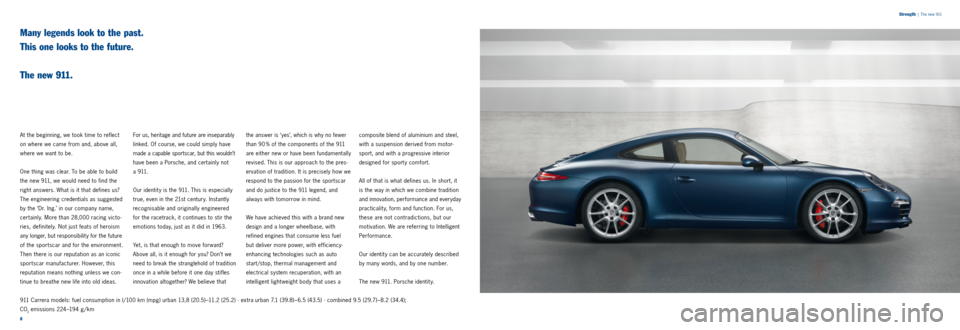
9
8
Many legends look to the past.
This one looks to the future.
The new 911.
At the beginning, we took time to reflect
on where we came from and, above all,
where we want to be.
One thing was clear. To be able to build
the new 911, we would need to find the
right answers. What is it that defines us?
The engineering credentials as suggested
by the ‘Dr. Ing.’ in our company name,
certainly. More than 28,000 racing victo -
ries, definitely. Not just feats of heroism
any longer, but responsibilit y for the future
of the sportscar and for the environment.
Then there is our reputation as an iconic
sportscar manufacturer. However, this
reputation means nothing unless we con -
tinue to breathe new life into old ideas. For us, heritage and future are inseparably
linked. Of course, we could simply have
made a capable sportscar, but this wouldn’t
have been a Porsche, and certainly not
a 9 11 .
Our identit y is the 911. This is especially
true, even in the 21st century. Instantly
recognisable and originally engineered
for the racetrack, it continues to stir the
emotions today, just as it did in 1963.
Yet, is that enough to move forward?
Above all, is it enough for you? Don’t we
need to break the stranglehold of tradition
once in a while before it one day stifles
innovation altogether? We believe that
the answer is ‘yes’, which is why no fewer
than 90 % of the components of the 911
are either new or have been fundamentally
revised. This is our approach to the pres -
ervation of tradition. It is precisely how we
respond to the passion for the sportscar
and do justice to the 911 legend, and
always with tomorrow in mind.
We have achieved this with a brand new
design and a longer wheelbase, with
refined engines that consume less fuel
but deliver more power, with efficiency-
enhancing technologies such as auto
start /stop, thermal management and
electrical system recuperation, with an
intelligent light weight body that uses a composite blend of aluminium and steel,
with a suspension derived from motor
-
sport, and with a progressive interior
designed for sport y comfort.
All of that is what defines us. In short, it
is the way in which we combine tradition
and innovation, performance and everyday
practicality, form and function. For us,
these are not contradictions, but our
motivation. We are referring to Intelligent
Performance.
Our identit y can be accurately described
by many words, and by one number.
The new 911. Porsche identit y.
911 Carrera models: fuel consumption in l/100 km (mpg) urban 13,8 (20.5) –11.2 (25.2) · extra urban 7.1 (39.8) – 6.5 (43.5) · combined 9.5 (29.7) –8.2 (34.4);
CO
2 emissions 224–194 g / km
Strength | The new 911
Page 7 of 63
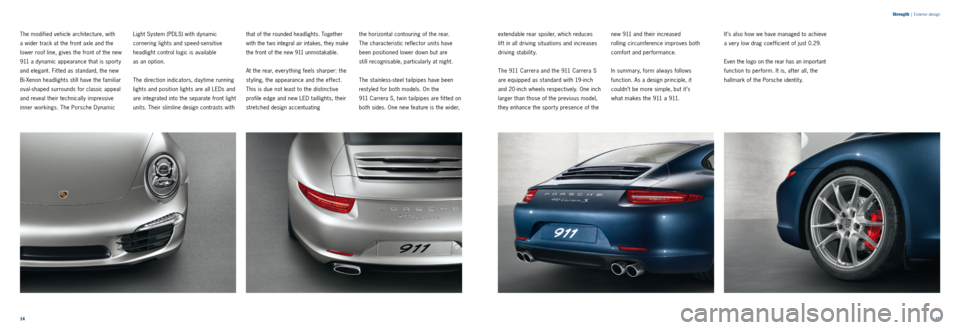
1415
Strength
|
Exterior design
The modified vehicle architecture, with
a wider track at the front axle and the
lower roof line, gives the front of the new
911 a dynamic appearance that is sport y
and elegant. Fit ted as standard, the new
Bi-Xenon headlights still have the familiar
oval-shaped surrounds for classic appeal
and reveal their technically impressive
inner workings. The Porsche Dynamic Light System (PDLS) with dynamic
cornering lights and speed-sensitive
headlight control logic is available
as an option.
The direction indicators, daytime running
lights and position lights are all LEDs and
are integrated into the separate front light
units. Their slimline design contrasts with that of the rounded headlights. Together
with the two integral air intakes, they make
the front of the new 911 unmistakable.
At the rear, every thing feels sharper: the
styling, the appearance and the effect.
This is due not least to the distinctive
profile edge and new LED taillights, their
stretched design accentuating the horizontal contouring of the rear.
The characteristic reflector units have
been positioned lower down but are
still recognisable, particularly at night.
The stainless-steel tailpipes have been
rest yled for both models. On the
911 Carrera S, twin tailpipes are fitted on
both sides. One new feature is the wider, extendable rear spoiler, which reduces
lift in all driving situations and increases
driving stability.
The 911 Carrera and the 911 Carrera S
are equipped as standard with 19-inch
and 20-inch wheels respectively. One inch
larger than those of the previous model,
they enhance the sport y presence of the new 911 and their increased
rolling circumference improves both
comfort and performance.
In summary, form always follows
function. As a design principle, it
couldn’t be more simple, but it ’s
what makes the 911 a 911.
It ’s also how we have managed to achieve
a very low drag coefficient of just 0.29.
Even the logo on the rear has an important
function to perform. It is, after all, the
hallmark of the Porsche identity.
Page 8 of 63
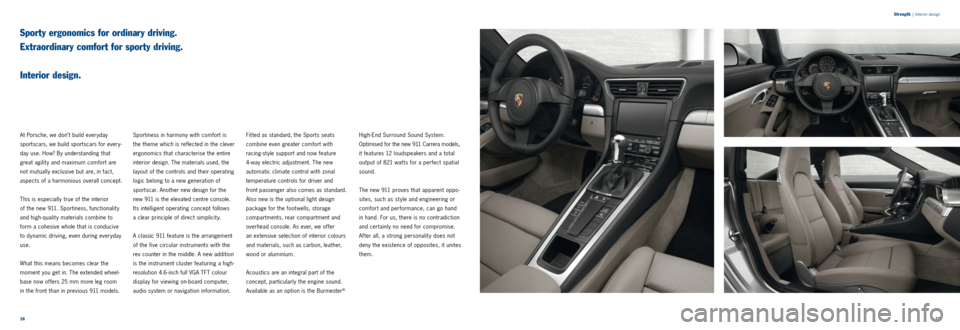
1617
Strength
|
Interior design
Sporty ergonomics for ordinary driving.
Extraordinary comfort for sporty driving.
Interior design.
At Porsche, we don’t build everyday
sportscars, we build sportscars for every -
day use. How? By understanding that
great agilit y and maximum comfort are
not mutually exclusive but are, in fact,
aspects of a harmonious overall concept.
This is especially true of the interior
of the new 911. Sportiness, functionality
and high-quality materials combine to
form a cohesive whole that is conducive
to dynamic driving, even during everyday
use.
What this means becomes clear the
moment you get in. The extended wheel -
base now offers 25 mm more leg room
in the front than in previous 911 models. Sportiness in harmony with comfort is
the theme which is reflected in the clever
ergonomics that characterise the entire
interior design. The materials used, the
layout of the controls and their operating
logic belong to a new generation of
sportscar. Another new design for the
new 911 is the elevated centre console.
Its intelligent operating concept follows
a clear principle of direct simplicity.
A classic 911 feature is the arrangement
of the five circular instruments with the
rev counter in the middle. A new addition
is the instrument cluster featuring a high-
resolution 4.6-inch full VGA TFT colour
display for viewing on-board computer,
audio system or navigation information. Fit ted as standard, the Sports seats
combine even greater comfort with
racing-st yle support and now feature
4 -way electric adjustment. The new
automatic climate control with zonal
temperature controls for driver and
front passenger also comes as standard.
Also new is the optional light design
package for the foot wells, storage
compartments, rear compartment and
overhead console. As ever, we offer
an extensive selection of interior colours
and materials, such as carbon, leather,
wood or aluminium.
Acoustics are an integral part of the
concept, particularly the engine sound.
Available as an option is the Burmester
® High-End Surround Sound System.
Optimised for the new 911 Carrera models,
it features 12 loudspeakers and a total
output of 821 wat ts for a perfect spatial
sound.
The new 911 proves that apparent oppo -
sites, such as st yle and engineering or
comfort and performance, can go hand
in hand. For us, there is no contradiction
and certainly no need for compromise.
After all, a strong personalit y does not
deny the existence of opposites, it unites
them.
Page 9 of 63
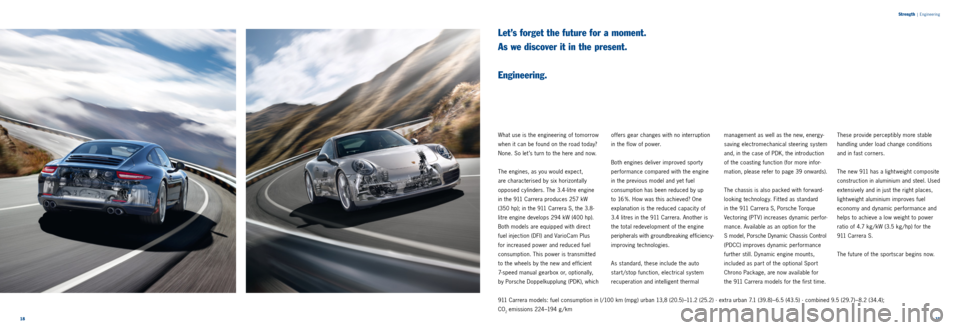
1819
Strength
|
Engineering
Let’s forget the future for a moment.
As we discover it in the present.
Engineering.
What use is the engineering of tomorrow
when it can be found on the road today?
None. So let ’s turn to the here and now.
The engines, as you would expect,
are characterised by six horizontally
opposed cylinders. The 3.4-litre engine
in the 911 Carrera produces 257 kW
(350 hp); in the 911 Carrera S, the 3.8-
litre engine develops 294 kW (400 hp).
Both models are equipped with direct
fuel injection (DFI) and VarioCam Plus
for increased power and reduced fuel
consumption. This power is transmit ted
to the wheels by the new and efficient
7-speed manual gearbox or, optionally,
by Porsche Doppelkupplung (PDK), which offers gear changes with no interruption
in the flow of power.
Both engines deliver improved sport y
performance compared with the engine
in the previous model and yet fuel
consumption has been reduced by up
to 16 %. How was this achieved? One
explanation is the reduced capacit y of
3.4 litres in the 911 Carrera. Another is
the total redevelopment of the engine
peripherals with groundbreaking efficiency-
improving technologies.
As standard, these include the auto
start/stop function, electrical system
recuperation and intelligent thermal management as well as the new, energy-
saving electromechanical steering system
and, in the case of PDK, the introduction
of the coasting function (for more infor
-
mation, please refer to page 39 onwards).
The chassis is also packed with forward-
looking technology. Fit ted as standard
in the 911 Carrera S, Porsche Torque
Vectoring (PT V) increases dynamic perfor -
mance. Available as an option for the
S model, Porsche Dynamic Chassis Control
(PDCC) improves dynamic performance
further still. Dynamic engine mounts,
included as part of the optional Sport
Chrono Package, are now available for
the 911 Carrera models for the first time. These provide perceptibly more stable
handling under load change conditions
and in fast corners.
The new 911 has a light weight composite
construction in aluminium and steel. Used
extensively and in just the right places,
lightweight aluminium improves fuel
economy and dynamic performance and
helps to achieve a low weight to power
ratio of 4.7 kg / kW (3.5 kg / hp) for the
9 11 C a r r e r a S .
The future of the sportscar begins now.
911 Carrera models: fuel consumption in l/100 km (mpg) urban 13,8 (20.5) –11.2 (25.2) · extra urban 7.1 (39.8) – 6.5 (43.5) · combined 9.5 (29.7) –8.2 (34.4);
CO
2 emissions 224–194 g / km
Page 10 of 63
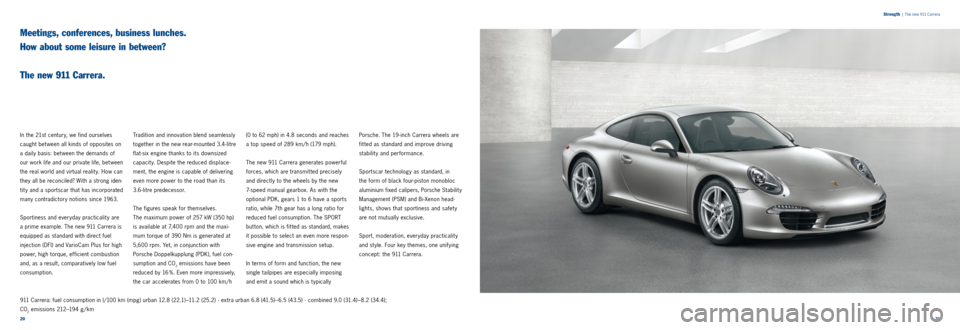
2021
Strength
| The new 911 Carrera
Meetings, conferences, business lunches.
How about some leisure in between?
The new 911 Carrera.
In the 21st century, we find ourselves
caught bet ween all kinds of opposites on
a daily basis: bet ween the demands of
our work life and our private life, between
the real world and virtual realit y. How can
they all be reconciled? With a strong iden -
tit y and a sportscar that has incorporated
many contradictory notions since 1963.
Sportiness and everyday practicality are
a prime example. The new 911 Carrera is
equipped as standard with direct fuel
injection (DFI) and VarioCam Plus for high
power, high torque, ef ficient combustion
and, as a result, comparatively low fuel
consumption. Tradition and innovation blend seamlessly
together in the new rear-mounted 3.4-litre
flat-six engine thanks to its downsized
capacity. Despite the reduced displace
-
ment, the engine is capable of delivering
even more power to the road than its
3.6-litre predecessor.
The figures speak for themselves.
The maximum power of 257 kW (350 hp)
is available at 7,400 rpm and the maxi -
mum torque of 390 Nm is generated at
5,600 rpm. Yet, in conjunction with
Porsche Doppelkupplung (PDK), fuel con -
sumption and CO
2 emissions have been
reduced by 16 %. Even more im pres
sively,
the car accelerates from 0 to 100 km/ h
(0 to 62 mph) in 4.8 seconds and reaches
a top speed of 289 km/ h (179 mph).
The new 911 Carrera generates powerful
forces, which are transmit ted precisely
and directly to the wheels by the new
7-speed manual gearbox. As with the
optional PDK, gears 1 to 6 have a sports
ratio, while 7th gear has a long ratio for
reduced fuel consumption. The SPORT
but ton, which is fit ted as standard, makes
it possible to select an even more respon -
sive engine and transmission setup.
In terms of form and function, the new
single tailpipes are especially imposing
and emit a sound which is t ypically Porsche. The 19-inch Carrera wheels are
fit ted as standard and improve driving
stability and performance.
Sportscar technology as standard, in
the form of black four-piston monobloc
aluminium fixed calipers, Porsche Stability
Management (PSM) and Bi-Xenon head -
lights, shows that sportiness and safety
are not mutually exclusive.
Sport, moderation, everyday practicality
and st yle. Four key themes, one unifying
concept: the 911 Carrera.
911 Carrera: fuel consumption in l/100 km (mpg) urban 12.8 (22.1) –11.2 (25.2) · extra urban 6.8 (41.5) – 6.5 (43.5) · combined 9.0 (31.4) –8.2 (34.4);
CO
2 emissions 212–194 g / km
Page 11 of 63
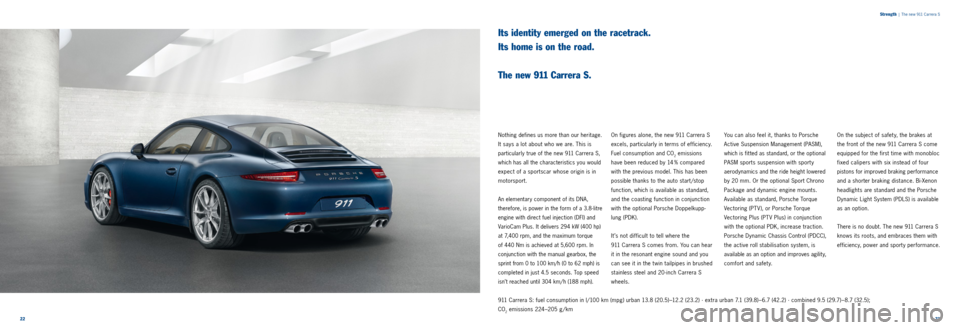
2223
Strength
| The new 911 Carrera S
Its identity emerged on the racetrack.
Its home is on the road.
The new 911 Carrera S.
Nothing defines us more than our heritage.
It says a lot about who we are. This is
particularly true of the new 911 Carrera S,
which has all the characteristics you would
expect of a sportscar whose origin is in
motorsport.
An elementary component of its DNA,
therefore, is power in the form of a 3.8-litre
engine with direct fuel injection (DFI) and
VarioCam Plus. It delivers 294 kW (400 hp)
at 7,400 rpm, and the maximum torque
of 440 Nm is achieved at 5,600 rpm. In
conjunction with the manual gearbox, the
sprint from 0 to 100 km/h (0 to 62 mph) is
completed in just 4.5 seconds. Top speed
isn’t reached until 304 km/ h (188 mph).
On figures alone, the new 911 Carrera S
excels, particularly in terms of efficiency.
Fuel consumption and CO
2 em issio ns
have been reduced by 14 % compared
with the previous model. This has been
possible thanks to the auto start /stop
function, which is available as standard,
and the coasting function in conjunction
with the optional Porsche Doppelkupp -
lung (PDK).
It ’s not difficult to tell where the
911 Carrera S comes from. You can hear
it in the resonant engine sound and you
can see it in the t win tailpipes in brushed
stainless steel and 20 - inch Carrera S
wheels. You can also feel it, thanks to Porsche
Active Suspension Management (PASM),
which is fit ted as standard, or the optional
PASM sports suspension with sport y
aerodynamics and the ride height lowered
by 20 mm. Or the optional Sport Chrono
Package and dynamic engine mounts.
Available as standard, Porsche Torque
Vectoring (PTV), or Porsche Torque
Vectoring Plus (PTV Plus) in conjunction
with the optional PDK, increase traction.
Porsche Dynamic Chassis Control (PDCC),
the active roll stabilisation system, is
available as an option and improves agility,
comfort and safet y. On the subject of safet y, the brakes at
the front of the new 911 Carrera S come
equipped for the first time with monobloc
fixed calipers with six instead of four
pistons for improved braking performance
and a shorter braking distance. Bi-Xenon
headlights are standard and the Porsche
Dynamic Light System (PDLS) is available
as an option.
There is no doubt. The new 911 Carrera S
knows its roots, and embraces them with
efficiency, power and sporty performance.
911 Carrera S: fuel consumption in l/100 km (mpg) urban 13.8 (20.5) –12.2 (23.2) · extra urban 7.1 (39.8) – 6.7 (42.2) · combined 9.5 (29.7) –8.7 (32.5);
CO
2 emissions 224–205 g / km
Page 13 of 63

2627
Temperament
|
Engines
To give more and take less.
That’s Porsche engineering.
Engines.
You could ask whether the sportscar is
still relevant. It would be a good question,
but you might as well ask the same of
dreams.
The answer to both questions lies in
the future or, to be more precise, in the
future of the sportscar. In the new 911,
the future has already begun. The highly
ef ficient, state - of-the -art engines make
a considerable contribution to reducing
fuel consumption, but their sound is still
unmistakably Porsche. The new 911 engines are also unmistaka
-
bly sport y thanks to the new SPORT
but ton fit ted as standard. At the push
of a button, the engine becomes tuned
for a sharper response and engine
dynamics that are even more direct.
The 3.4-litre engine of the new
911 Carrera demonstrates, therefore,
that performance and efficiency need
not be mutually exclusive. Rather, the
downsized engine capacity and increased
maximum torque are the intelligent basis
by which power output can be increased
in an environmentally acceptable and
sustainable way. Fuel consumption and CO2 emissions have been reduced
by up to 16 % compared with the previous
model.
In their search for improved efficiency,
our engineers analysed an extensive
series of engine components. Answers
were found, including rapid heating
of the engine and gearbox by the new
thermal management after an engine
start, optimised air induction and the
extremely effective direct fuel injection
(DFI).
The same principle applies to the 3.8-litre
engine in the 911 Carrera S. There has been no change in displacement since
the previous model, but power output has
been increased while fuel consumption
has been reduced by up to 14 %.
Weight is critical to efficiency. This is
why the engines have a light-alloy
construction, which makes them light -
weight and structurally rigid for improved
fuel economy and a long life.
The engine is the intelligent core of our
identit y. What else could the ‘Dr. Ing.’ in
our company name possibly stand for?
911 Carrera models: fuel consumption in l/100 km (mpg) urban 13,8 (20.5) –11.2 (25.2) · extra urban 7.1 (39.8) – 6.5 (43.5) · combined 9.5 (29.7) –8.2 (34.4);
CO
2 emissions 224–194 g / km
Page 14 of 63
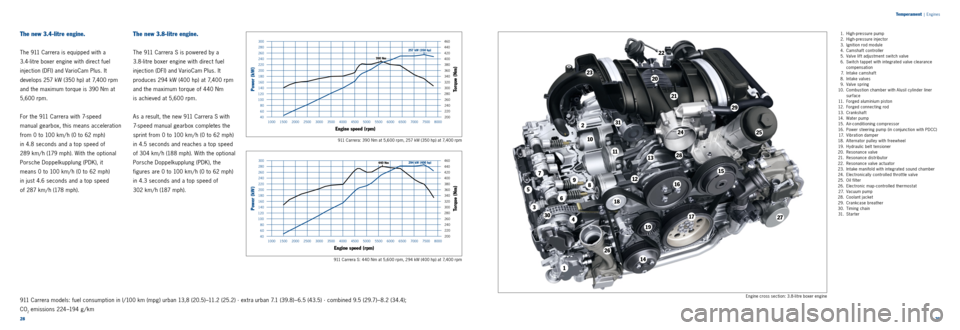
1
2
3
4
5
6
7
89
10
11
12
13
14
15
16
17
18
19
20
21
22
23
2425
26
27
28
29
30
31
2829
Temperament
|
Engines
Engine cross section: 3.8-litre boxer engine
911 Carrera S: 440 Nm at 5,600 rpm, 294 kW (400 hp) at 7,400 rpm
1. High - pressure pump
2. High-pressure injector
3. Ignition rod module
4. Camshaft controller
5. Valve lif t adjustment switch valve
6. Switch tappet with integrated valve clearance
compensation
7. Intake camshaf t
8. Intake valves
9. Valve spring
10. Combustion chamber with Alusil cylinder liner
surface
11. Forged aluminium piston
12. Forged connecting rod
13. Crankshaft
14. Water pump
15. Air-conditioning compressor
16. Power steering pump (in conjunction with PDCC)
17. Vibration damper
18. Alternator pulley with freewheel
19. Hydraulic belt tensioner
20. Resonance valve
21. Resonance distributor
22. Resonance valve actuator
23. Intake manifold with integrated sound chamber
24. Electronically controlled throttle valve
25. Oil filter
26. Electronic map-controlled thermostat
27. Vacuum pump
28. Coolant jacket
29. Crankcase breather
30. Timing chain
31. S t a r t e r
911 Carrera: 390 Nm at 5,600 rpm, 257 kW (350 hp) at 7,400 rpm
The new 3.4-litre engine.
The 911 Carrera is equipped with a
3.4-litre boxer engine with direct fuel
injection (DFI) and VarioCam Plus. It
develops 257 kW (350 hp) at 7,400 rpm
and the maximum torque is 390 Nm at
5,600 rpm.
For the 911 Carrera with 7-speed
manual gearbox, this means acceleration
from 0 to 100 km/ h (0 to 62 mph)
in 4.8 seconds and a top speed of
289 km/ h (179 mph). With the optional
Porsche Doppelkupplung (PDK), it
means 0 to 100 km/ h (0 to 62 mph)
in just 4.6 seconds and a top speed
of 287 km/ h (178 mph).
The new 3.8-litre engine.
The 911 Carrera S is powered by a
3.8-litre boxer engine with direct fuel
injection (DFI) and VarioCam Plus. It
produces 294 kW (400 hp) at 7,400 rpm
and the maximum torque of 440 Nm
is achieved at 5,600 rpm.
As a result, the new 911 Carrera S with
7-speed manual gearbox completes the
sprint from 0 to 100 km/ h (0 to 62 mph)
in 4.5 seconds and reaches a top speed
of 304 km/ h (188 mph). With the optional
Porsche Doppelkupplung (PDK), the
figures are 0 to 100 km/ h (0 to 62 mph)
in 4.3 seconds and a top speed of
302 km/ h (187 mph).
911 Carrera models: fuel consumption in l/100 km (mpg) urban 13,8 (20.5) –11.2 (25.2) · extra urban 7.1 (39.8) – 6.5 (43.5) · combined 9.5 (29.7) –8.2 (34.4);
CO
2 emissions 224–194 g / km
40 60 80
100
120 140 160 180 200 220 240 260
1500 75008000
2000 2500300035004000450050005500600065007000
1000
294 kW (400 hp)440 Nm
300
280
Power (kW)
T orque (Nm)
Engine speed (rpm)
200
280 300 320 340 360 380 400 420
220 240 260
460
440
40
60 80
100 120 140 160 180 200 220 240 260
1500 75008000
2000 2500300035004000450050005500600065007000
1000
300
280
Power (kW)
T orque (Nm)
Engine speed (rpm)
200
280 300 320 340 360 380
400 420
220 240 260
460
440
257 kW (350 hp)
390 Nm
Page 17 of 63
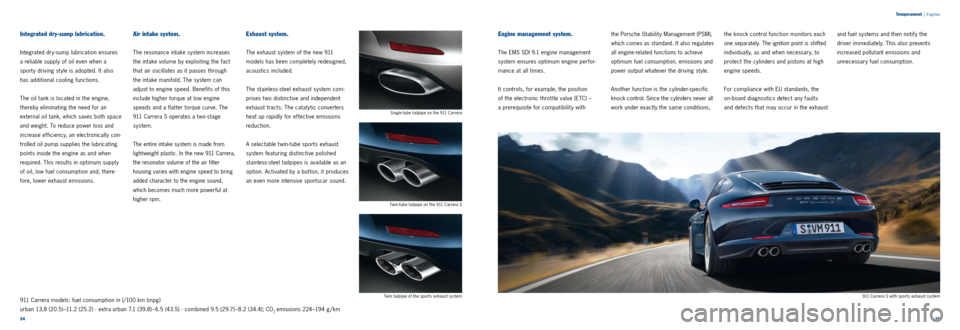
3435
Temperament
|
Engines
Integrated dry-sump lubrication.
Integrated dr y-sump lubrication ensures
a reliable supply of oil even when a
sport y driving st yle is adopted. It also
has additional cooling functions.
The oil tank is located in the engine,
thereby eliminating the need for an
external oil tank, which saves both space
and weight. To reduce power loss and
increase efficiency, an electronically con -
trolled oil pump supplies the lubricating
points inside the engine as and when
required. This results in optimum supply
of oil, low fuel consumption and, there -
fore, lower exhaust emissions.
Air intake system.
The resonance intake system increases
the intake volume by exploiting the fact
that air oscillates as it passes through
the intake manifold. The system can
adjust to engine speed. Benefits of this
include higher torque at low engine
speeds and a flat ter torque curve.
The
911 Carrera S operates a t wo -stage
system.
The entire intake system is made from
light weight plastic. In the new 911 Carrera,
the resonator volume of the air filter
housing varies with engine speed to bring
added character to the engine sound,
which becomes much more powerful at
higher rpm.
Exhaust system.
The exhaust system of the new 911
models has been completely redesigned,
acoustics included.
The stainless-steel exhaust system com -
prises t wo distinctive and independent
exhaust tracts. The cataly tic converters
heat up rapidly for effective emissions
reduction.
A selectable t win -tube sports exhaust
system featuring distinctive polished
stainless-steel tailpipes is available as an
option. Activated by a but ton, it produces
an even more intensive sportscar sound.
911 Carrera S with sports exhaust system
Engine management system.
The EMS SDI 9.1 engine management
system ensures optimum engine perfor -
mance at all times.
It controls, for example, the position
of the electronic throt tle valve (ETC) –
a prerequisite for compatibility with the Porsche Stabilit y Management (PSM),
which comes as standard. It also regulates
all engine-related functions to achieve
optimum fuel consumption, emissions and
power output whatever the driving st yle.
Another function is the cylinder-specific
knock control. Since the cylinders never all
work under exactly the same conditions, the knock control function monitors each
one separately. The ignition point is shifted
individually, as and when necessary, to
protect the cylinders and pistons at high
engine speeds.
For compliance with EU standards, the
on - board diagnostics detect any faults
and defects that may occur in the exhaust and fuel systems and then notify the
driver immediately. This also prevents
increased pollutant emissions and
unnecessary fuel consumption.
Twin tailpipe of the sports exhaust system Single-tube tailpipe on the 911 Carrera
Twin-tube tailpipe on the 911 Carrera S911 Carrera models: fuel consumption in l/100 km (mpg)
urban 13,8 (20.5) –11.2 (25.2) · extra urban 7.1 (39.8) – 6.5 (43.5) · combined 9.5 (29.7) –8.2 (34.4); CO
2 emissions 224–194 g / km
Page 19 of 63

462135
7R
3839
Porsche Doppelkupplung (PDK).
Available as an option for the new 911
models is 7-speed PDK, featuring manual
and automatic modes. This double - clutch
transmission has been further refined and
enables extremely fast gear changes with
no interruption in the flow of power, which vastly improves acceleration at the
same time as reducing fuel consumption.
In total, PDK has seven gears at its disposal.
Gears 1 to 6 have a sports ratio and top
speed is reached in 6th gear. 7th gear has
a long ratio and helps to reduce fuel
consumption by keeping engine revs low.
Porsche Doppelkupplung (PDK)
PDK is essentially t wo gearboxes in one
and thus requires t wo clutches. This
double-clutch arrangement provides an
alternating, non-positive connection
bet ween the t wo half gearboxes and the
engine by means of t wo separate input
shafts.The flow of power from the engine is
transmit ted through one half gearbox and
one clutch at a time, while the next gear
is preselected in the second half gearbox.
During a gear change, therefore, one
clutch simply opens and the other closes
at the same time, enabling gear changes
to take place within milliseconds.
Temperament | Transmission
The effect is instant. Driving feels even
sportier and more dynamic, and agility
is increased. Depending on the gearshift
programme (SPORT button activated
or deactivated), the gear change is opti -
mised for comfort or for sport y driving.With the optional Sport Chrono Package,
PDK is enhanced by the ‘Launch Control’
and ‘motorsport- derived gearshif t strategy’
functions (p. 50). In this way, optimum use is made of the
vehicle’s momentum, allowing it to coast
for longer distances.
For example, you may want to slow down
from 100 km/ h (62 mph) to 80 km/ h
(49 mph) in anticipation of the change of
speed limit ahead. As soon as you release
the accelerator pedal, PDK deselects
the current gear automatically and you
begin to coast in neutral until you have
reached your desired speed. The moment
you engage the accelerator or brake
pedal, PDK selects the appropriate gear
smoothly and seamlessly within a fraction
of a second.
Another way to reduce fuel consumption is
to utilise the coasting function on downhill
gradients that are gentle enough for you
to maintain a constant speed. Efficient on
long journeys, such as on the motorway,
PDK remains ready to respond as swiftly
and precisely as you would expect.
In short, driving in coasting mode makes
a real impact on fuel consumption without
any need for compromise on comfort or
sporty performance.
Coasting.
The ‘coasting’ function available with
Porsche Doppelkupplung (PDK) enables
you to save even more fuel where the
situation allows. The engine is decoupled
from the transmission to prevent
deceleration caused by engine braking.